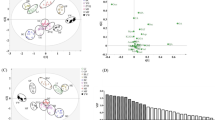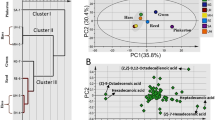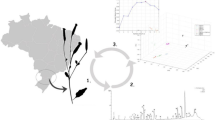Abstract
Introduction
Bitter melon (Momordica charantia, Cucurbitaceae) is a popular edible medicinal plant, which has been used as a botanical dietary supplement for the treatment of diabetes and obesity in Chinese folk medicine. Previously, our team has proved that cucurbitanes triterpenoid were involved in bitter melon’s anti-diabetic effects as well as on increasing energy expenditure. The triterpenoids composition can however be influenced by changes of varieties or habitats.
Objectives
To clarify the significance of bioactive metabolites diversity among different bitter melons and to provide a guideline for selection of bitter melon varieties, an exploratory study was carried out using a UHPLC-HRMS based metabolomic study to identify chemotypes.
Methods
Metabolites of 55 seed samples of bitter melon collected in different parts of China were profiled by UHPLC-HRMS. The profiling data were analysed with multivariate (MVA) statistical methods. Principle component analysis (PCA) and hierarchical cluster analysis (HCA) were applied for sample differentiation. Marker compounds were identified by comparing spectroscopic data with isolated compounds, and additional triterpenes were putatively identified by propagating annotations through a molecular network (MN) generated from UHPLC-HRMS & MS/MS metabolite profiling.
Results
PCA and HCA provided a good discrimination between bitter melon samples from various origins in China. This study revealed for the first time the existence of two chemotypes of bitter melon. Marker compounds of those two chemotypes were identified at different MSI levels. The combined results of MN and MVA demonstrated that the two chemotypes mainly differ in their richness in cucurbitane versus oleanane triterpenoid glycosides (CTGs vs. OTGs).
Conclusion
Our finding revealed a clear chemotype distribution of bioactive components across bitter melon varieties. While bioactivities of individual CTGs and OTGs still need to be investigated in more depth, our results could help in future the selection of bitter melon varieties with optimised metabolites profile for an improved management of diabetes with this popular edible Chinese folk medicine.





Similar content being viewed by others
Data availability
The data in this study are deposited in MetaboLights (https://www.ebi.ac.uk/metabolights/) study identifier MTBLS701.
References
Ayeleso, T. B., Matumba, M. G., & Mukwevho, E. (2017). Oleanolic acid and its derivatives: Biological activities and therapeutic potential in chronic diseases. Molecules, 22(11), 1915. https://doi.org/10.3390/molecules22111915.
Bao, B., Chen, Y. G., Zhang, L., Na Xu, Y. L., Wang, X., Liu, J., et al. (2013). Momordica charantia (Bitter Melon) reduces obesity-associated macrophage and mast cell infiltration as well as inflammatory cytokine expression in adipose tissues. PLoS ONE, 8(12), e84075. https://doi.org/10.1371/journal.pone.0084075.
Bhatia, A., Bharti, S. K., Tewari, S. K., Sidhu, O. P., & Roy, R. (2013). Metabolic profiling for studying chemotype variations in Withania somnifera (L.) Dunal fruits using GC-MS and NMR spectroscopy. Phytochemistry, 93, 105–115. https://doi.org/10.1016/j.phytochem.2013.03.013.
Duan, J., Yin, Y., Cui, J., Yan, J., Zhu, Y., Guan, Y., et al. (2016). Chikusetsu saponin IVa ameliorates cerebral ischemia reperfusion injury in diabetic mice via adiponectin-mediated AMPK/GSK-3beta pathway in vivo and in vitro. Molecular Neurobiology, 53(1), 728–743. https://doi.org/10.1007/s12035-014-9033-x.
FDA. (2013). Bioanalytical method validation. Guidance for industry. http://www.fda.gov/Drugs/GuidanceComplianceRegulatoryInformation/%20Guidances/ucm064964.htm. Accessed February 2017.
Hall, C. (2017). Dictionary of natural products on CD-ROM. London: Chapman & Hall.
Harinantenaina, L., Tanaka, M., Takaoka, S., Oda, M., Mogami, O., Uchida, M., et al. (2006). Momordica charantia constituents and antidiabetic screening of the isolated major compounds. Chemical and Pharmaceutical Bulletin (Tokyo), 54(7), 1017–1021.
Iseli, T. J., Turner, N., Zeng, X. Y., Cooney, G. J., Kraegen, E. W., Yao, S., et al. (2013). Activation of AMPK by bitter melon triterpenoids involves CaMKKbeta. PLoS ONE, 8(4), e62309. https://doi.org/10.1371/journal.pone.0062309.
Kaiser, S., Carvalho, A. R., Pittol, V., Dietrich, F., Manica, F., Machado, M. M., et al. (2016). Genotoxicity and cytotoxicity of oxindole alkaloids from Uncaria tomentosa (cat’s claw): Chemotype relevance. Journal of Ethnopharmacology, 189, 90–98. https://doi.org/10.1016/j.jep.2016.05.026.
Keller, A. C., Ma, J., Kavalier, A., He, K., Brillantes, A. M., & Kennelly, E. J. (2011). Saponins from the traditional medicinal plant Momordica charantia stimulate insulin secretion in vitro. Phytomedicine, 19(1), 32–37. https://doi.org/10.1016/j.phymed.2011.06.019.
Leung, L., Birtwhistle, R., Kotecha, J., Hannah, S., & Cuthbertson, S. (2009). Anti-diabetic and hypoglycaemic effects of Momordica charantia (bitter melon): a mini review. British Journal of Nutrition, 102(12), 1703–1708. https://doi.org/10.1017/S0007114509992054.
Luyen, N. T., Dang, N. H., Binh, P. T. X., Hai, N. T., & Dat, N. T. (2018). Hypoglycemic property of triterpenoid saponin PFS isolated from Polyscias fruticosa leaves. Anais da Academia Brasileira de Ciências, 90, 2881–2886. https://doi.org/10.1590/0001-3765201820170945.
Mohimani, H., Gurevich, A., Mikheenko, A., Garg, N., Nothias, L. F., Ninomiya, A., et al. (2017). Dereplication of peptidic natural products through database search of mass spectra. Nature Chemical Biology, 13(1), 30–37. https://doi.org/10.1038/nchembio.2219.
Murakami, T., Emoto, A., Matsuda, H., & Yoshikawa, M. (2001). Medicinal foodstuffs. XXI. Structures of new cucurbitane-type triterpene glycosides, goyaglycosides-a, -b, -c, -d, -e, -f, -g, and -h, and new oleanane-type triterpene saponins, goyasaponins I, II, and III, from the fresh fruit of Japanese Momordica charantia L. Chemical & Pharmaceutical Bulletin, 49(1), 54–63.
Nakamura, S., Murakami, T., Nakamura, J., Kobayashi, H., Matsuda, H., & Yoshikawa, M. (2006). Structures of new cucurbitane-type triterpenes and glycosides, karavilagenins and karavilosides, from the dried fruit of Momordica charantia L. in Sri Lanka. Chemical & Pharmaceutical Bulletin (Tokyo), 54(11), 1545–1550.
Okabe, H., Miyahara, Y., Yamauchi, T., Miyahara, K., & Kawasaki, T. (1980). Studies on the constituents of Momordica charantia L. I. Isolation and characterization of momordicosides A and B, glycosides of a pentahydroxy-cucurbitane triterpene. Chemical & Pharmaceutical Bulletin, 28(9), 2753–2762. https://doi.org/10.1248/cpb.28.2753.
Pan, Y., Zhang, J., Shen, T., Zhao, Y. L., Zuo, Z. T., Wang, Y. Z., et al. (2016). Investigation of chemical diversity in different parts and origins of ethnomedicine Gentiana rigescens Franch using targeted metabolite profiling and multivariate statistical analysis. Biomedical Chromatography, 30(2), 232–240. https://doi.org/10.1002/bmc.3540.
Pluskal, T., Castillo, S., Villar-Briones, A., & Oresic, M. (2010). MZmine 2: Modular framework for processing, visualizing, and analyzing mass spectrometry-based molecular profile data. BMC Bioinformatics, 11, 395. https://doi.org/10.1186/1471-2105-11-395.
Popovich, D. G., Lee, Y., Li, L., & Zhang, W. (2011). Momordica charantia seed extract reduces pre-adipocyte viability, affects lactate dehydrogenase release, and lipid accumulation in 3T3-L1 cells. Journal of Medicinal Food, 14, 201–208. https://doi.org/10.1089/jmf.2010.1150.
Queiroz, E. F., Alfattani, A., Afzan, A., Marcourt, L., Guillarme, D., & Wolfender, J. L. (2019). Utility of dry load injection for an efficient natural products isolation at the semi-preparative chromatographic scale. Journal of Chromatography A, 1598, 85–91. https://doi.org/10.1016/j.chroma.2019.03.042.
Sathishsekar, D., & Subramanian, S. (2005). Antioxidant properties of Momordica Charantia (bitter gourd) seeds on Streptozotocin induced diabetic rats. Asia Pacific Journal of Clinical Nutrition, 14(2), 153–158.
Shibuya, H., Kawashima, K., Sakagami, M., Kawanishi, H., Shimomura, M., Ohashi, K., et al. (1990). Sphingolipids and glycerolipids. I. Chemical structures and ionophoretic activities of soya-cerebrosides I and II from soybean. Chemical & Pharmaceutical Bulletin, 38(11), 2933–2938.
Singh, A., Singh, S. P., & Bamezai, R. (1998a). Momordica charantia (Bitter Gourd) peel, pulp, seed and whole fruit extract inhibits mouse skin papillomagenesis. Toxicology Letters, 94(1), 37–46.
Singh, A., Singh, S. P., & Bamezai, R. (1998b). Postnatal efficacy of Momordica charantia peel, pulp, seed and whole fruit extract in the detoxication pathway of suckling neonates and lactating mice. Cancer Letters, 122(1–2), 121–126.
Soro, L. C., Munier, S., Pelissier, Y., Grosmaire, L., Yada, R., Kitts, D., et al. (2016). Influence of geography, seasons and pedology on chemical composition and anti-inflammatory activities of essential oils from Lippia multiflora Mold leaves. Journal of Ethnopharmacology, 194, 587–594. https://doi.org/10.1016/j.jep.2016.10.047.
Sumner, L. W., Amberg, A., Barrett, D., Beale, M. H., Beger, R., Daykin, C. A., et al. (2007). Proposed minimum reporting standards for chemical analysis Chemical Analysis Working Group (CAWG) metabolomics standards initiative (MSI). Metabolomics, 3, 211–221. https://doi.org/10.1007/s11306-007-0082-2.
Tan, M. J., Ye, J. M., Turner, N., Hohnen-Behrens, C., Ke, C. Q., Tang, C. P., et al. (2008). Antidiabetic activities of triterpenoids isolated from bitter melon associated with activation of the AMPK pathway. Chemistry & Biology, 15, 263–273. https://doi.org/10.1016/j.chembiol.2008.01.013.
Tomita, K., Tamiya, G., Ando, S., Kitamura, N., Koizumi, H., Kato, S., et al. (2005). AICAR, an AMPK activator, has protective effects on alcohol-induced fatty liver in rats. Alcoholism, Clinical and Experimental Research, 29(12 Suppl), 240S–245S.
Wang, M., Carver, J. J., Phelan, V. V., Sanchez, L. M., Garg, N., Peng, Y., et al. (2016). Sharing and community curation of mass spectrometry data with global natural products social molecular networking. Nature Biotechnology, 34(8), 828–837. https://doi.org/10.1038/nbt.3597.
Wolfender, J. L., Litaudon, M., Touboul, D., & Queiroz, E. F. (2019a). Innovative omics-based approaches for prioritisation and targeted isolation of natural products—New strategies for drug discovery. Natural Products Reports, 36(6), 855–868. https://doi.org/10.1039/c9np00004f.
Wolfender, J. L., Nuzillard, J. M., van der Hooft, J. J. J., Renault, J. H., & Bertrand, S. (2019b). Accelerating metabolite identification in natural product research: Toward an ideal combination of liquid chromatography-high-resolution tandem mass spectrometry and NMR profiling, in silico databases, and chemometrics. Analytical Chemistry, 91(1), 704–742. https://doi.org/10.1021/acs.analchem.8b05112.
Xu, J., Cao, K., Li, Y., Zou, X., Chen, C., Szeto, I. M., et al. (2014). Bitter gourd inhibits the development of obesity-associated fatty liver in C57BL/6 mice fed a high-fat diet. Journal of Nutrition, 144(4), 475–483. https://doi.org/10.3945/jn.113.187450.
Yang, S. Y., Kim, H. K., Lefeber, A. W., Erkelens, C., Angelova, N., Choi, Y. H., et al. (2006). Application of two-dimensional nuclear magnetic resonance spectroscopy to quality control of ginseng commercial products. Planta Medica, 72(4), 364–369. https://doi.org/10.1055/s-2005-916240.
Ye, M., Liu, S. H., Jiang, Z., Lee, Y., Tilton, R., & Cheng, Y. C. (2007). Liquid chromatography/mass spectrometry analysis of PHY906, a Chinese medicine formulation for cancer therapy. Rapid Communications in Mass Spectrometry, 21(22), 3593–3607. https://doi.org/10.1002/rcm.2832.
Zeng, X. Y., Wang, Y. P., Cantley, J., Iseli, T. J., Molero, J. C., Hegarty, B. D., et al. (2012). Oleanolic acid reduces hyperglycemia beyond treatment period with Akt/FoxO1-induced suppression of hepatic gluconeogenesis in type-2 diabetic mice. PLoS ONE, 7(7), e42115. https://doi.org/10.1371/journal.pone.0042115.
Acknowledgements
We are thankful for the financial support of the Sino-Swiss Science and Technology Cooperation (SSSTC) program (Grant No. EG 08-032014). Financial support from the National Natural Science Foundation of China (Grant Nos. 81573305, 81673327) is also acknowledged.
Author information
Authors and Affiliations
Contributions
YY and JLW designed the project and supervised the data analysis. SZ performed the chemical experiments and UHPLC-HRMS analysis. SZ and PMA performed data analysis. SZ, CQ and CT performed the quantitation analysis. SZ and CW wrote the manuscript. All authors edited and approved the manuscript.
Corresponding authors
Ethics declarations
Conflict of interest
The authors declare that they have no conflict of interest.
Research involving human and animal participants
This article does not contain any studies with human and/or animal participants performed by any of the authors.
Additional information
Publisher's Note
Springer Nature remains neutral with regard to jurisdictional claims in published maps and institutional affiliations.
Electronic supplementary material
Below is the link to the electronic supplementary material.
Rights and permissions
About this article
Cite this article
Zhou, S., Allard, PM., Wolfrum, C. et al. Identification of chemotypes in bitter melon by metabolomics: a plant with potential benefit for management of diabetes in traditional Chinese medicine. Metabolomics 15, 104 (2019). https://doi.org/10.1007/s11306-019-1565-7
Received:
Accepted:
Published:
DOI: https://doi.org/10.1007/s11306-019-1565-7




